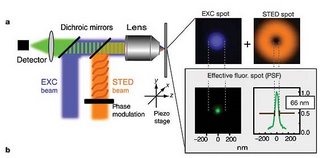Three Brief Papers on Nuclear Pore Complexes
The nuclear membrane separates the nuclear space from the cytoplasm. This barrier is comprised of two membranes (Inner and Outer Nuclear Membrane) that are continuous with the endoplasmic reticulum. To cross the double membrane, molecules traverse the nuclear pore complex (NPC), a giant macromolecular complex that has an eight-fold symmetry and weighs over 100MDa. To date, only two components of the NPC have been identified: gp210 and Pom120. Interestingly many cells only express one of these proteins. Well it seems like Dirk Gorlich’s group have been able to knock out BOTH genes from Hela cells … and the cells are fine! They have NPCs, they can reform the nuclear membrane after mitosis … something strange is going on (On top of that another group previously claimed that gp210 was essential … in Hela cells!)
Nuclear pore complex assembly and maintenance in POM121- and gp210-deficient cells
Fabrizia Stavru, Gitte Nautrup-Pedersen, Volker C. Cordes, and Dirk Görlich
JCB (2006) 173:477-83
In a second paper the Gorlich group solve the problem … there is a third integral membrane protein that is part of the NPC, called Ncd1. Turns out that yeast don’t have gp210 or Pom120 orthologues. Instead they have Ncd1 and two other non-conserved integral membrane proteins, Pom152 and Pom34. Of the three, Ncd1 is the only protein that is essential and conserved in other organisms. Interestingly Ncd1 is also part of the yeast spindle pole body, a structure related to our centrosomes … (Does this sound interesting Gomez?). The Gorlich lab show that there are Ncd1 orthologues that localize to NPCs in fly, frogs, worms, humans
The Gorlich lab knocked down Ncd1 in Hela and the NPCs were defective (lower staining of NPC components). Worm knockouts were mostly inviable.
NDC1: a crucial membrane-integral nucleoporin of metazoan nuclear pore complexes Fabrizia Stavru, Bastian B. Hülsmann, Anne Spang, Enno Hartmann, Volker C. Cordes, and Dirk Görlich JCB (2006) 173:509-19
Last is a paper from Martin Hetzer’s lab. Here they tackle the tricky question of how do you form NPCs. There are two times when you have to form these structures; after mitosis when the nuclear envelope reforms, and during interphase as the nucleus expands. Using complicated in vitro manipulations of nuclei formed from frog egg extracts, the Hertzer lab shows that active Ran is required both in the nuclear and cytoplasmic compartments to activate NPC formation in an expanding nucleus (an analogous situation to NPC formation in interphase). They offer evidence that ran acts to dissociate the Nup107complex, which is a major constituent of the NPC) from Importin-beta in both the nucleoplasm and cytoplasm. Interestingly they show that excess free Nup107 complex can stimulate NPC formation IN NUCLEI THAT DO NOT HAVE NPCs. That means that exogenously added Nup107 complex can stimulate the fusion of the Outer Nuclear Membrane and Inner Nuclear Membrane, to form a hole where the NPC sits. They then observe that gp210 form patches on the nuclear envelope and may act as landing pads for Nup107 complex in intact nuclei.
What this last paper shows is that within the lumen of the nuclear envelope threre is some machinery that acts to fuse the two membranes to form pores. What is the machine? Well it looks like of the integral membrane proteins, gp210 and Pom120 are dispensable. Ncd1? There are survivors of the Ncd1 knockouts in worms. These survivors also have NPCs. Thus it is likely that a whole fusion complex exists but is waiting for someone to find it …
Nuclear Pores Form de Novo from Both Sides of the Nuclear Envelope
Maximiliano A. D’Angelo, Daniel J. Anderson, Erin Richard, Martin W. Hetzer
Science (2006) 312:440-443
Cross posted at the Daily Transcript.


